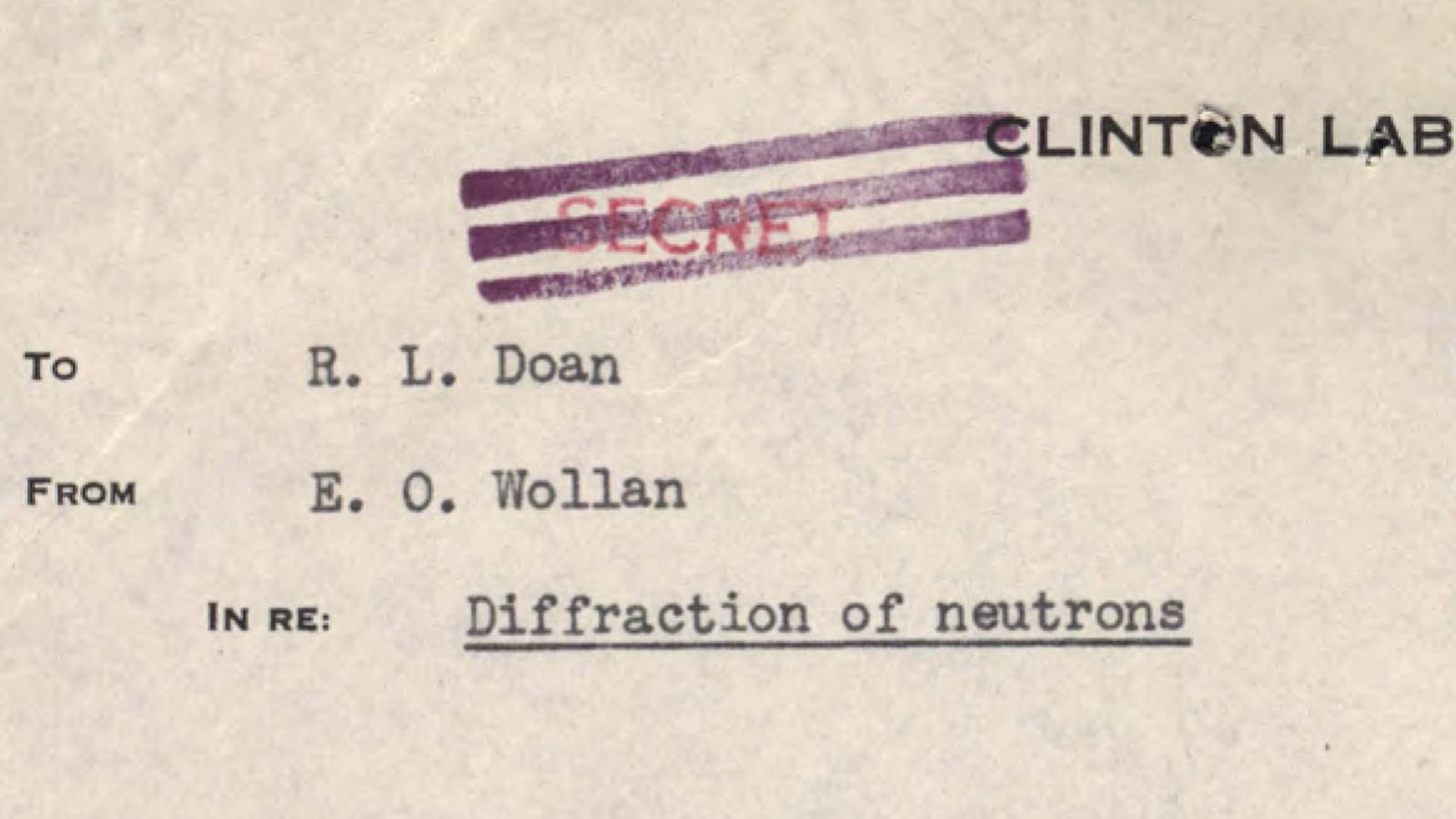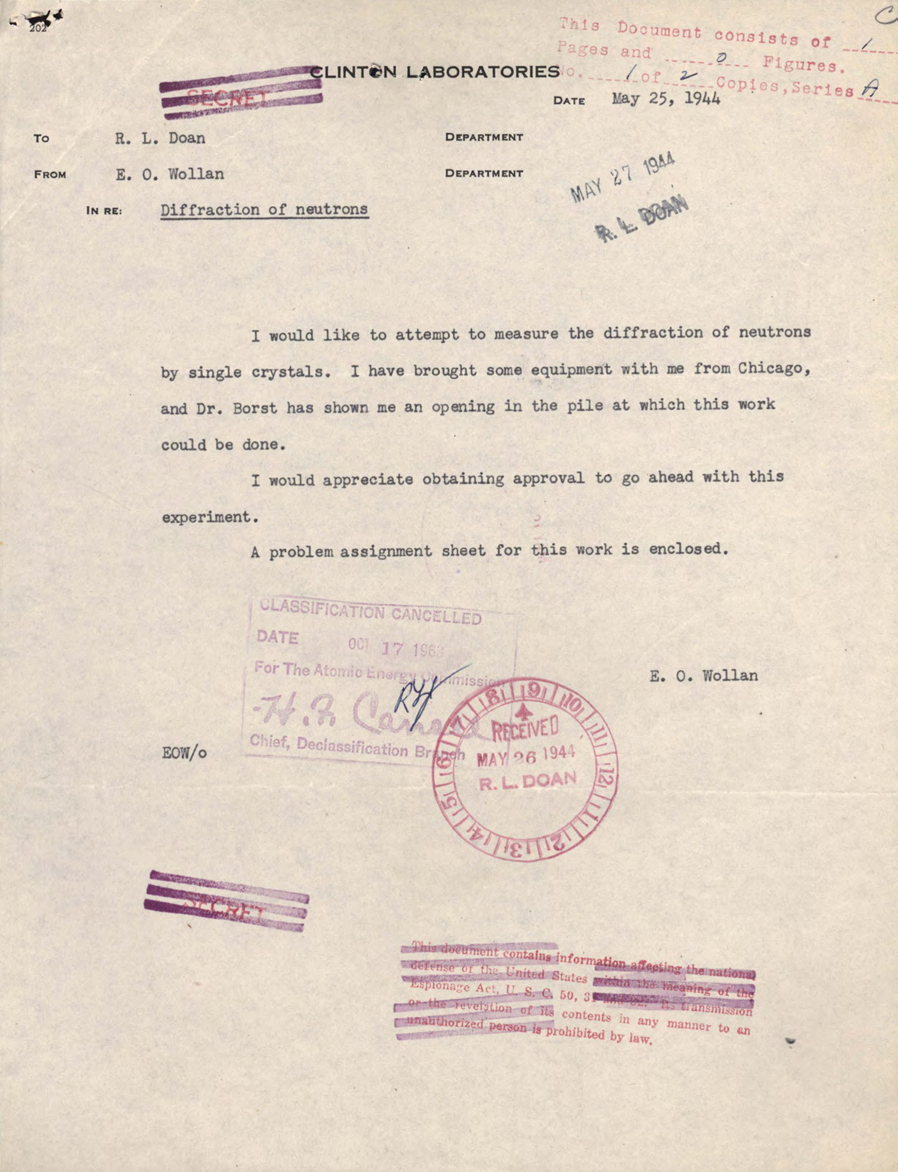The first nuclear reactors, developed in the 1940s to produce fissionable materials for atomic weapons, paved the way for a new and intriguing research technique that led to a Nobel Prize and innovations in a number of fields in science and engineering.
Called neutron diffraction, the technique is used today to understand, exploit, and improve the structural properties of a wide range of materials and objects, from viruses to high-temperature superconductors to turbine blades for jet engines.
In May 1944, physicist Ernest O. Wollan sent this letter to Richard L. Doan, director of research at Clinton Laboratories (later named Oak Ridge National Laboratory). While work on the Manhattan Project was still in full swing (and led to the classification of this letter as “secret”), he proposed an experiment on the world’s first continuously operating nuclear reactor, the X-10 pile at Clinton Laboratories.
Wollan was among the first to recognize the scientific potential of high-intensity neutron sources. He worked at the Metallurgical Laboratory at the University of Chicago, where he helped to determine the shielding requirements of CP-1, the world’s first nuclear reactor, and he was present at the startup of both the CP-1 and the X-10 pile. An expert in using the diffraction of X-rays to explore the structure of matter, Wollan realized that neutrons could also serve as tools for measuring nuclear properties and determining the atomic and magnetic structures of materials. Neutrons have no electrical charge, and they can penetrate deep inside any material. He suspected that when neutrons bounced off the atoms inside a sample, they would reflect—similar to X-rays—in certain directions, revealing the position of the sample’s atoms.
Wollan’s request to Doan was granted in May 1944, but his early attempts to diffract neutrons from a gypsum crystal were unsuccessful. In a parallel effort, initiated by physicist Enrico Fermi at the Met Lab’s CP-3 reactor, physicist Walter Zinn observed in August 1944 that neutron scattering indeed can produce, at specific wavelengths and angles, intense peaks of reflected neutrons, which provide the key to the atomic structure of the material.
The following month, Wollan transferred to Clinton Laboratories. He acquired what he later called “much more satisfactory equipment,” including an X-ray spectrometer borrowed from the University of Chicago’s Physics Department. Within a few months, he demonstrated neutron diffraction from both gypsum and rock salt. He went on to launch a comprehensive experimental program on the development of neutron diffraction techniques and their application to studies of solids and liquids.
When the war was over, Clifford G. Shull, who had received his PhD in physics from New York University in 1941, paid a visit to Clinton Laboratories and saw the work by Wollan. He joined Wollan’s research efforts in 1946. Within two years, Wollan and Shull had completed a systematic investigation of the fundamentals of the scattering of slow, low-energy neutrons by crystalline powders, obtained the first successful neutron diffraction patterns from crystals and published their first review article. Further development of neutron diffraction enabled advances in nuclear physics, crystallography and chemical binding, and magnetism.
The 1994 Nobel Prize in physics recognized “the development of the neutron diffraction technique,” 10 years after Wollan’s death, when Shull won the award. (The Nobel Prize is not awarded posthumously.)
Today, particle accelerators provide scientists with an additional source of neutrons for research. In 1999, Shull attended the groundbreaking for the Spallation Neutron Source at Oak Ridge National Laboratory, where neutrons are produced by bombarding a target with intense proton beams from an accelerator and six neutron diffractometers record and analyze diffraction patterns, providing unmatched capabilities for understanding the structure and properties of materials. A fellowship program bearing Shull’s name provides young science and engineering graduates an opportunity to develop their own innovative research programs.








